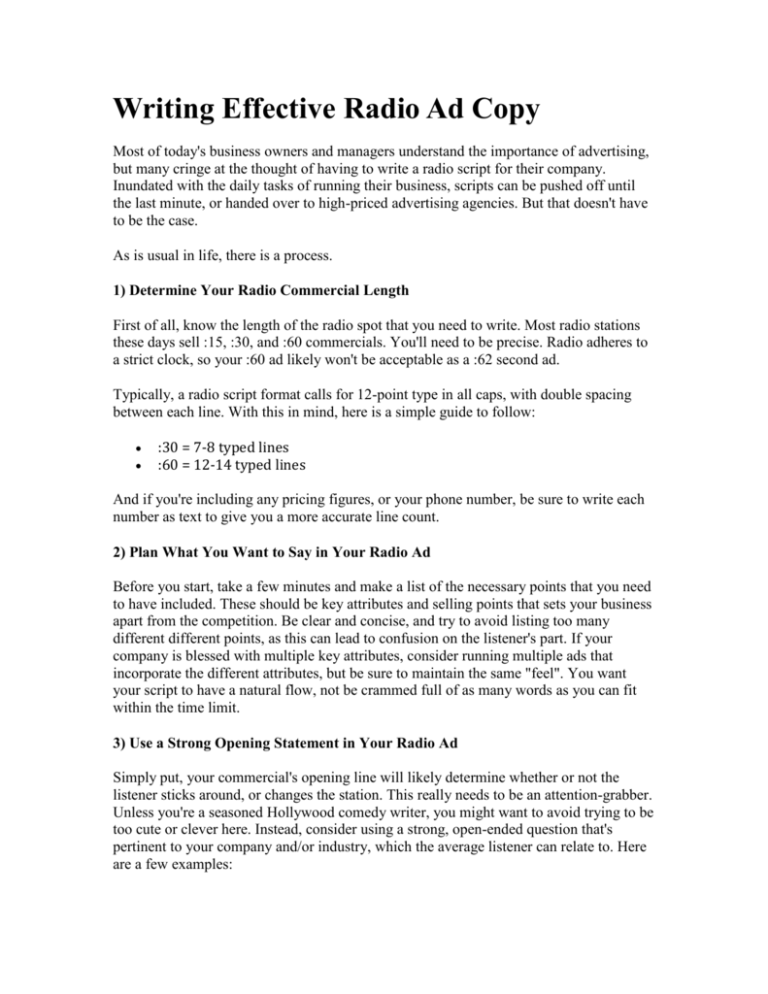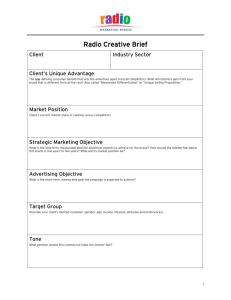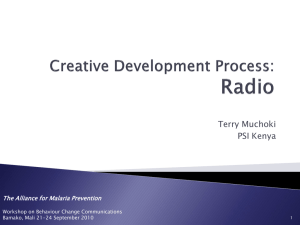How to Write an Effective Radio Commercial
advertisement

Writing Effective Radio Ad Copy Most of today's business owners and managers understand the importance of advertising, but many cringe at the thought of having to write a radio script for their company. Inundated with the daily tasks of running their business, scripts can be pushed off until the last minute, or handed over to high-priced advertising agencies. But that doesn't have to be the case. As is usual in life, there is a process. 1) Determine Your Radio Commercial Length First of all, know the length of the radio spot that you need to write. Most radio stations these days sell :15, :30, and :60 commercials. You'll need to be precise. Radio adheres to a strict clock, so your :60 ad likely won't be acceptable as a :62 second ad. Typically, a radio script format calls for 12-point type in all caps, with double spacing between each line. With this in mind, here is a simple guide to follow: :30 = 7-8 typed lines :60 = 12-14 typed lines And if you're including any pricing figures, or your phone number, be sure to write each number as text to give you a more accurate line count. 2) Plan What You Want to Say in Your Radio Ad Before you start, take a few minutes and make a list of the necessary points that you need to have included. These should be key attributes and selling points that sets your business apart from the competition. Be clear and concise, and try to avoid listing too many different different points, as this can lead to confusion on the listener's part. If your company is blessed with multiple key attributes, consider running multiple ads that incorporate the different attributes, but be sure to maintain the same "feel". You want your script to have a natural flow, not be crammed full of as many words as you can fit within the time limit. 3) Use a Strong Opening Statement in Your Radio Ad Simply put, your commercial's opening line will likely determine whether or not the listener sticks around, or changes the station. This really needs to be an attention-grabber. Unless you're a seasoned Hollywood comedy writer, you might want to avoid trying to be too cute or clever here. Instead, consider using a strong, open-ended question that's pertinent to your company and/or industry, which the average listener can relate to. Here are a few examples: Are you paying too much for car insurance? Is your home as safe as it could be? When is the last time you enjoyed a really good burger? By posing a question like this, right out of the box, the listener could be compelled to want to hear the answer, and the rest of your ad. 4) Include Key Attributes and Your Company Personality in Your Radio Ad The purpose of an ad -- any ad -- is to arouse enough curiosity that the target is compelled to act upon it. Get that? You don't need your ad to close the deal; you just want it to tease your product or service enough that the target decides to contact you. And that's where you and your staff come in. With the body of the ad, address the opening question in a clear and concise manner, while working your company's key attributes into the mix. In a :60 ad, you'll want to include your company's name at least 4 times. Shoot for 3 times in a :30, and at least twice in a :15. And, unless you have trained voice actors available, keep the script to one person. It's a lot safer. Also, show your company's personality. Known for having the lowest prices in town? Say it. Environmentally focused? Say it. Sell the only authentic German widgets within a 40 mile radius? Say it. Don't be afraid to brag a little here-just don't overdo it. 5) Use Effective Contact Info in Your Radio Ad Just use a phone number, right? Not necessarily. When you consider that a large portion of your audience will be driving, cooking, working out, or engaged in some other activity as they're hearing your ad, most won't have a pen and paper ready to write down your digits. Which means that unless you have a Nursery School-simple number like 1-800 BIG-JOES, you'll have to repeat it, which takes up a lot of script space. And you STILL won't have guaranteed retention. Instead, consider using your web address. Most of the time they're a lot easier to recall, and it gives the listener a 24 hour point of access to your business. 6) Further Suggestions for your Radio Script Above all, adhere to the K-I-S-S rule. The most effective ads usually do. And remember to time your script after you're done. If you don't have a stopwatch available, double-click on the clock on the bottom right of your computer screen, and use the pop-up. Ideally, you'd like to bring the script in a few seconds short. This will give the station's production manager time to add a music intro or outro, and allow him or her to not have to rush the read. Proper utilization of these six points will allow you to take a more seasoned approach with your copywriting, and should garner better end results. Writing a radio script isn't rocket science, but it can be daunting. However, if you can convey a few select points and ideas in a clear and concise manner, and keep your target interested, your radio campaign will indeed pay dividends. Engaging Emotions Through Effective Radio Ads Engaging Emotions Through Effective Radio Ads is the second part of a Radio Ad Lab project originally conducted by Gallup & Robinson (G&R) in 2007 and designed to assess how well Radio ads generate emotional responses and engage with consumers, compared to television ads. Findings from the study reveal that in effective Radio ads: Strong beginnings make a difference. An involving point of entry distinguishes some of the most successful Radio ads. Word selection matters. Words that are sensory-laden, emotional, or empowering have a demonstrable impact on the emotional reactions of consumers. Audio can be powerful. Audio can generate stronger emotions than visuals, especially when the tonality in the ad is used effectively. Brand mentions have an impact. The best Radio ads mention the advertiser’s brand multiple times, strategically placed to correlate with moments of high consumer engagement. The highest scoring and best performing ad in the study exhibited all of the above, a strong indication that Radio commercials are highly engaging to consumers when the creative process follows these patterns. How to Write an Effective Radio Commercial If you are a local radio advertiser and you depend on a radio station sales rep to create your radio copy and ad campaigns, you are most likely getting ineffective results from your advertising dollar. I have been involved in local radio advertising for nearly 30 years, or all of my adult life. There is a constant in the radio sales area and that is that a radio salesperson is really more concerned about his or her next order than getting you effective results from yours. Most of the time a salesperson has no real experience in writing effective copy. Most of them dislike the task and consider it a chore. You might be surprised to know that most radio properties don't feel the need to have a full time copy writer on staff. So it is up to the sales rep to put something together for you. They'll sit down and start writing until they've come up with the requisite number of words but with no real concept. The copy tends to be full of superlatives like "for the best in…" and "for all your (insert product here) needs…." Other favorites are… "the best service at the lowest price with the most knowledgeable sales people." What are they really saying? The truth is, almost nothing. For many years I was in the position of trying to help these people help their clients by coming up with more effective copy. I was a radio Production Director. During that time, I developed somewhat of a formula for an effective radio ad. One of the battles you face is the ignorance of the average local advertiser. They want to fill their spots with a laundry list of what we call in the biz… "price and item." Any good advertising expert will tell you that laundry lists don't work. At best the listener will hear only the first and last item on the list, and they won't retain it. Another waste of air time is phone numbers. Most local advertisers are so conditioned by print advertising that they think radio works the same way. It doesn't... They try arcane methods like "radio coupons" to try and track the effectiveness of the campaign. "Radio coupons" simply don't work. What these business owners fail to realize is that radio is all about "impressions" and "saturation." A good radio ad delivers a simple repetitive message. As much as radio people would like to believe that listeners are hanging on every word, they're not. It's is a message in the background, almost subliminal. The message has to be strong and simple. If you listen to national radio advertisers and how they do it, you'll start to pick up on this concept. The best example I can give you of this is a radio ad Sears ran many years ago for Die Hard batteries. It was simply the sound of a car attempting to start. The starter would crank but no ignition. With each successive try the starter would crank for a shorter period of time until finally all you heard was a click. Then an announcer said simply… "Die Hard batteries, available at Sears." This is the kind of radio ad that works. It's relatable and it's simple. So, for local advertisers, I would come up with a concept. I would develop the concept in the first thirty seconds of a sixty second spot and then to appease the print ad minded advertiser, give him twenty seconds of details. Then for the last ten seconds of the ad, I would reprise back to the concept. This way I had a chance to make an effective ad and still give the advertiser his say. With phone numbers in radio spots, they simply don't work unless the whole focus of the spot is the phone number. For instance, a local Pizza chain a few years back put in a single number to call for all their locations to order Pizza for any location around the city. Naturally they wanted to promote this phone number. So, they had a jingle produced that simply said… "Call 895-1111, 895-1111, Call 895-1111 for Pizza Hut delivery." That is all it said, over and over to a musical melody. Of course this was widely successful. A simple repetitive message and the catchiness of a jingle so it gets "stuck in your head." Just an announcer repeating the phone number three times at the end of a laundry list simply doesn't work. Another good tip is when you give an address for a business... instead of just saying "at 333 Third Street," you can say something like "at Third and Main across from City Hall." It's all about landmarks. Give them a point of reference. In some ways, radio advertising should be handled much like Internet pay-per-click keyword advertising. Instead of broad terms about a broad range of products, pick one product to promote at a time. Get them in the store with a good deal whether they buy or not. Create "foot traffic." It leads to sales. Another common spot template that is ineffective is what we call in the industry a "hey honey I'm home spot" or "dialogue spot." This is where there is an inane conversation going on between two bad actors that are talking in ways that no one does. Very stilted and filled with phone numbers and details. At best you will get attention with these spots only due to how bad they are as people laugh at your business. In radio, it is important to use sound. Sound is the medium. You can use effective sound effects as in the Sears Die Hard spot or you can use "dry" text to stand out among all the noise. Just make the dry text slow, deliberate and powerful, and with a very simple message. I remember one many years ago like this for an acne product that said in a deep voice with no music or other sound… "a few more cents, a few less zits." Very powerful. I hope I've given you some insight into the subject of being creative with you radio spots. Look around you, notice what gets people excited about your product and find a simple message to get you noticed and then keep repeating it over an over. Be consistent. 4 Keys to Radio Advertising In a single week, radio reaches more than 228 million Americans. That's 94 percent of everyone age 12 and older, according to Arbitron . So no matter what types of prospects you want to reach, radio advertising will help you do it. Plus, radio is mobile. Eighty percent of adults listen to radio in their cars, and a quarter of the population also listens while at work. There's a lot that's new in radio. Many stations now stream their programming on the internet and reach additional local and even national audiences. What's more, if online listeners like what they hear in your streaming radio spot, they're just one click away from your website. Radio provides an ideal advertising medium for small businesses, but running an effective campaign takes a bit of know-how. Just follow these four tips for navigating the radio waves. 1. Pinpoint Your Audience. Every radio buy must begin with a clear understanding of the listeners you want to reach. Write a onesentence target audience profile based on the demographics of your prospects. This should include their age, gender, where they live and other factors, such as household income. Then share this information with the sales reps from the stations you're considering. They'll tell you what percentage of their stations' listeners match these demographics and at what times of the day or during which programming you'll reach your best prospects. There also may be qualitative characteristics of your ideal prospects you should consider when making your radio buy. A restaurant owner, for example, would look for a radio station whose listeners dine out frequently. The radio station sales reps have access to both qualitative and quantitative information concerning their listeners and should be able to give you customized proposals that include schedules with ratings breakdowns. They should also provide signal coverage maps that show precisely where their stations are heard. 2. Know What You're Buying. The three most important elements when evaluating proposals are reach, frequency and cost-per-point. Reach is the number of your prospects that'll hear your marketing message. Frequency isn't the number of spots you run, but the average number of times your prospects will actually hear your message. Cost-perpoint is the basis for evaluating cost effectiveness. CPP is what it'll cost to reach 1 percent of your target audience population, so it's the best way to compare the value of competing stations. Buy enough frequency to ensure your message is heard at least several times. 3. Look for Special Sponsorships. Radio stations are promotional engines, and there are at least two ways you can get on board. First, most stations offer the opportunity to sponsor news, weather reports or other types of regular programming. As a sponsor, you'll typically get additional mentions, such as with "billboards," which are announcements of your sponsorship that lead into special programming. Often, sponsorship will guarantee your spots air first in the commercial breaks, or pods, so you'll reach more listeners before they have a chance to switch stations or tune out during long breaks. Radio stations also get involved in the community with special events. Look for sponsorship opportunities that include on-air mentions, as well as visibility at the events themselves. And be sure to seek out events that are well attended by your target audience and put your company in the spotlight. 4. Entertain the Audience. Once you've evaluated the proposals from the radio stations and negotiated and finalized your buys, you'll need effective spots. Since radio spot production is rarely a do-it-yourself job, you'll most likely work with a local production company, agency or station. But you should understand a few basics to be an effective part of the team and keep them on track. Great radio spots grab and hold attention, usually through humor. They may also use sounds, compelling music or unusual voices to grab attention. Your spots must tell stories or present situations your target audience can relate to. To keep your audience listening to your spots month after month, make them part of an ongoing campaign theme. Your audience will listen for the newest versions, helping extend your message more successfully than if you were to run unrelated spots. For maximum results, make your call to action--a URL or phone number--easy to remember and tie it in with your company name or message.





